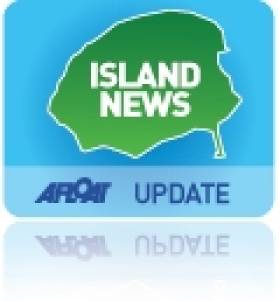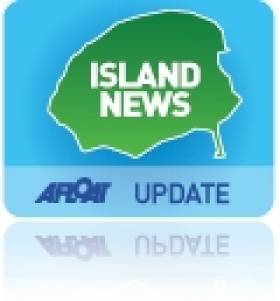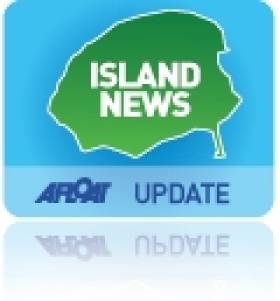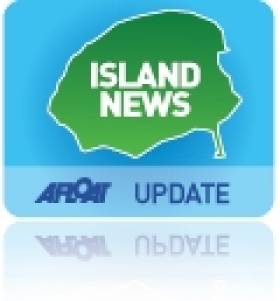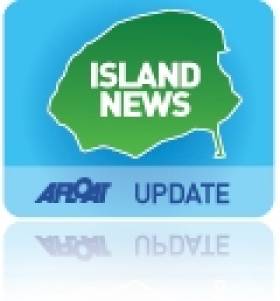Displaying items by tag: Holy island
Consultants Appointed To Prepare Plan For Holy Island On Lough Derg
Clare County Council has today announced the appointment of a team of specialists to prepare a Visitor Management and Sustainable Tourism Development Plan for Holy Island on Lough Derg.
Dublin-based Solearth Architecture is being engaged to prepare proposals in relation to improving access to the island and the provision of tourism facilities on or near the island, as well as proposals on the marketing and promoting of the Island as a visitor destination, while confirming its historical significance and protecting its built and natural heritage.
In June 2015, Clare County Council acquired 41 acres on Holy Island which, together with the 2 acres already in the ownership of the Office of Public Works (OPW), resulted in the entire island being brought into public ownership for the first time.
Dating back to the 7th century, the island is one of the most important historical and ecclesiastical sites in Ireland, and it has important links to Brian Ború. Buildings on the island include a 24-metre high Round Tower, an Oratory, and a number of churches. Holy Island is on the UNESCO world heritage site tentative list for Ireland as an early medieval monastic site along with Clonmacnoise, Durrow, Glendalough, Kells and Monasterboice.
"I welcome the progress that has been made in relation to the development of a comprehensive tourism development plan as part of the Council's ambitious and methodical approach to developing this important site in a sustainable manner," stated Councillor James Breen, Cathaoirleach of Clare County Council.
"The sustainable development of the island for the benefit of tourism and communities in the wider Lough Derg area has long been sought after by Elected Members of Clare County Council. It is very encouraging to see that significant steps are now being taken to develop a blueprint for tourism development and visitor management of the Island, whilst also ensuring the cultural heritage and natural assets that contribute to the Island’s uniqueness are maintained and protected," added the Cathaoirleach.
According to lead Architect, Brian O’Brien of Solearth Architecture, a practice noted for its sustainable design solutions: “Inis Cealtra is a precious gem and we are delighted to be entrusted with this delicate task of both minding it and finding ways to share it with more people for the benefit of the local and wider community”.
"We’ll be starting with public meetings to draw on the wisdom of the locals who really know the Island and will shortly set up a website to receive everyone’s thoughts throughout the process," concluded Mr. O'Brien.
Gerard Dollard, Director of Services, Clare County Council, noted that the Plan will take approximately 10 months to complete and will involve a significant level of community consultation.
The preparation of the Plan will incorporate consultation with key stakeholders including the Department of Arts, Heritage & the Gaeltacht, Waterways Ireland, Fáilte Ireland, and local tourism, community and angling organisations. The Council will also be engaging with the OPW as joint landowners and the body responsible for the historic monuments on Holy Island during the Plan preparation process.
Mr. Dollard said: "Holy Island is very much part of the fabric of the local community and continues to be used as a burial ground. Therefore, it is essential that the overall plan not only provides for the future management and development of this important site but takes full cognisance of the rich archaeology, landscape, wildlife and cultural heritage of the area."
He continued: "Solearth Architecture, who have brought together a comprehensive team of experts in the area of tourism product development, visitor management, archaeology and architectural conservation, ecology, landscape and cultural heritage, will be required to consider all of these aspects in recommending a framework for the future management and development of the island."
#holyisland – Clare County Council has confirmed it is seeking tenders from professional experts to produce an implementation strategy for visitor management and sustainable tourism development on Holy Island.
Earlier this month, the Local Authority acquired 41 acres on the island which, together with the 2 acres already in the ownership of the Office of Public Works (OPW), has resulted in the entire island being brought into public ownership for the first time.
The successful tenderer will be required to prepare proposals in relation to improving access to Holy Island and the provision of tourism facilities on or near the Island, as well as proposals on the marketing and promoting of the Island as a visitor destination.
The preparation of the Visitor Management and Sustainable Tourism Development Plan will also incorporate a public consultation process and consultation with key stakeholders, including the Council, OPW, Department of Arts, Heritage & the Gaeltacht, Waterways Ireland, Fáilte Ireland, Inland Waterways, adjoining Local Authorities, relevant statutory bodies, and local tourism, community and angling organisations.
Dating back to the 7th century, Holy Island is one of the most important historical and ecclesiastical sites in Ireland, and it has important links to Brian Ború. Buildings on the island include a 24-metre high Round Tower, an Oratory, and a number of churches. Holy Island is on the UNESCO world heritage site tentative list for Ireland as an early medieval monastic site along with Clonmacnoise, Durrow, Glendalough, Kells and Monasterboice.
Gerard Dollard, Director of Services, Clare County Council, said: "The Visitor Management and Sustainable Tourism Development Plan will provide a framework, in consultation with key stakeholders, for tourism development and visitor management of the Island, whilst also ensuring the cultural heritage and natural assets that contribute to the Island's uniqueness are maintained and protected."
"Holy Island is very much part of the fabric of the local community and continues to be used as a burial ground. Therefore, it is essential that the overall plan provides for the future management and development of this important site but takes full cognisance of the rich archaeology, landscape, wildlife and cultural heritage of the area. The successful tenderer will be required to consider all of these aspects in recommending a framework for the future management and development of the island," added Mr. Dollard.
#holyisland – Clare County Council has announced a comprehensive plan relating to the future tourism development and visitor management of the "Jewel of Lough Derg", Holy Island (Inis Cealtra) on Lough Derg, County Clare.
As Afloat.ie previously reported, at a ceremony in Mountshannon today, the Local Authority confirmed it has acquired 41 acres on the island which, together with the 2 acres already in the ownership of the Office of Public Works (OPW), now means that the entire island is, for the first time, in public ownership.
The Council also announced its intention to procure professional experts to prepare a Visitor Management and Tourism Development Plan for Holy Island which will provide a framework, in consultation with key stakeholders, for tourism development and visitor management of the Island, whilst also ensuring the cultural heritage and natural assets that contribute to the Island's uniqueness are maintained and protected.
Still used as a burial ground, the ruins and buildings still standing on Holy Island date back as far as the 7th century when the monastic site was established by St. Caimin. Buildings on the island include a 24-metre high Round Tower, an Oratory, and a number of churches.
Speaking at a function in the Mountshannon Hotel, following a visit to Holy Island, Cllr. John Crowe, the Cathaoirleach of Clare County Council said "Holy Island is one of the most important historical and ecclesiastical sites in Ireland, and it has important links to Brian Ború. It is on the UNESCO world heritage site tentative list for Ireland as an early medieval monastic site along with Clonmacnoise, Durrow, Glendalough, Kells and Monasterboice."
"It is the jewel in the crown for East Clare and I am delighted that Clare County Council has now concluded the purchase of 41 acres on the Island so that the Island is now in public ownership," he said.
The purchase of the Island has been funded by Clare County Council from its own resources and additional funding towards the production of a Visitor Management and Tourism Development Plan has been provided by the Lough Derg Marketing and Strategy Group.
"Clare County Council has invested significantly in tourism product at the Cliffs of Moher, the Burren, Doolin, Loop Head and now we have a tremendous opportunity to make available one of the most important monastic sites in Ireland to a wider audience," stated the Chief Executive of Clare County Council, Tom Coughlan.
"We fully understand and appreciate the significance of this site and the necessity to ensure that any proposals are sensitive to the natural environment and cultural heritage of the site. We look forward to working with all stakeholders as we progress the development of the Visitor Management and Tourism Development Plan," he added.
Council To Buy Holy Island on Lough Derg for €100k
#holyisland – Clare County Council has announced an additional €1.1m investment in service delivery and tourism, business and community development projects around the county during 2015.
The announcement follows the publication of the Local Authority's unaudited Annual Financial Statement (AFS) for 2014 which shows that the Council ended the year with a €611k surplus on a total revenue expenditure of circa €105m.
Clare County Council billed a total of €42.4m in commercial rates in 2014, which represents approximately 40.4% of Clare County Council's revenue expenditure in the year. The council collected €40.9m in rates in the year.
Announcing the unaudited AFS for 2014 at its May Monthly Meeting last evening (Monday), Clare County Council also confirmed additional allocations in 2014 to the Municipal Districts (€400,000), Shannon Area (€100,000), proposed acquisition by the Council of Holy Island on Lough Derg (€100,000), a Visitor Services facility at Doolin Pier (€100,000), Library and Museum Development (€100,000), and Kilrush's participation in the 2015 International Entente Florale competition (€50,000).
Provision has also been made for Public Light improvements (€100,000), Public Area enhancements (€100,000) and playgrounds throughout the County (€50,000).
Cllr. John Crowe, Cathaoirleach of Clare County Council has welcomed the overall positive result being reported in this unaudited AFS for 2014.
"Taking into consideration the fiscal challenges faced by the Council in the years since the economic downturn, this result has arisen from effective budget management of both expenditure and income throughout the organisation. I particularly welcome the significant progress being made in relation to the collection of billed commercial rates which bodes well for the future financial operation of the Council, while it also demonstrates the recovering that is ongoing in the local economy," he stated.
Tom Coughlan, Chief Executive of Clare County Council commented: "During the past five years, the Council's cumulative operating debit balance, which stood at €1.77m at the start of 2009, has been reduced to €800,000 at the end of 2014. This reduction in the cumulative deficit in a period of reduced funding and uncertain economic circumstances is a positive development and will have lasting implications for the delivery of services and investment in business and community development projects throughout Clare."
He continued: "The achievement of a positive result last year took place in the context of a number of significant changes brought about as a result of the Local Government Reform Act 2014. They include the abolition of Town Councils, changes to the budgeting process, the creation of new structures such as the Local Community Development Committee (LCDC) and Municipal Districts, the commencement of operations of the Local Enterprise Office (LEO) and the commencement of the operation of water services on behalf of Irish Water under a Service Level Agreement."
"I wish to acknowledge the commitment of Council staff and the support of the Council Members for achieving this positive result," added Mr. Coughlan.
Waterways Ireland Praises Tourism Potential Of Holy Island
#HolyIsland - Waterways Ireland's chief executive has said the agency would be "delighted" to work with Clare County Council to develop improved public access to Holy Island on Lough Derg.
Dawn Livingstone was speaking following a visit to Holy Island during which she was briefed by the local authority on its plans to secure the purchase of the island, as previously reported on Afloat.ie.
Regarded as one of the most important historical and ecclesiastical sites in Ireland, the island comprises some 50 acres, of which more than four acres are in the ownership of the Office of Public Works (OPW).
"Waterways Ireland would be delighted to work in partnership with the council to develop better access to Holy Island as part of a management plan for care of the important ecclesiastical monuments on the island has been developed," said Livingstone.
"Holy Island is one of a number of important historic sites associated with the inland waterways, which Waterways Ireland believe linked together form a heritage trail that would also bring new visitors to the waterways and local areas."
Livingstone was accompanied on her visit to Holy Island by Gerard Dollard, director of services with Clare County Council, who confirmed that the local authority is presently putting funding in place and signing contracts to acquire the land, and said the council "warmly welcomes" Waterways Ireland's interest in the project that would go up for consultation with "all stakeholders and the local community" following the purchase.
Holy Island lies close to the village of Mountshannon and is on the UNESCO World Heritage site tentative list as an Early Medieval Monastic site along with Clonmacnoise, Durrow, Glendalough, Kells and Monasterboice.
The island also has important links to Brian Ború and is known throughout East Clare as the 'Jewel of the Lough'. Still used as a burial ground, the ruins and buildings still standing on Holy Island date back as far as the 7th century when the monastic site was established by St Caimin. Tom MacSweeney has more on the island in his latest This Island Nation.
Clare Council to Purchase Lough Derg's Holy Island
#holyisland – Clare County Council today confirmed that it is an advanced stage of negotiations to secure the purchase of Holy Island (Inis Cealtra) on Lough Derg, the largest lake on the River Shannon.
Holy Island is one of the most important historical and ecclesiastical sites in Ireland, has important links to Brian Ború and is known throughout East Clare as the "Jewel of the Lough'. The island comprises some 50 acres of which more than 4 acres are in the ownership of the Office of Public Works (OPW).
Still used as a burial ground, the ruins and buildings still standing on Holy Island date back as far as the 7th century when the monastic site was established by St. Caimin. Buildings on the island include a 24-metre high Round Tower, an Oratory, and a number of churches. The Island lies close to the village of Mountshannon and is on the UNESCO World Heritage site tentative list as an Early Medieval Monastic site along with Clonmacnoise, Durrow, Glendalough, Kells and Monasterboice.
Cllr. John Crowe, Cathaoirleach of Clare County Council expressed his delight that discussions are at an advanced stage and said he is "confident the acquisition of this important site can be completed."
The Cathaoirleach added: "I briefed the Tourism Minister, Mr. Pascal Donohue, T.D., on the current status during his recent visit to Clare and I also have been in contact with the Minister for Arts, Heritage and the Gaeltacht and the Minister of State with responsibility for the OPW who already own land on the island. It would be tremendous to secure public ownership of Holy Island this year, considering it is the millennial anniversary of the death of Brian Ború."
"My Council colleagues as well as Clare's six Oireachtas members are very supportive of public ownership of this important site," he added.
Gerard Dollard, Director of Services, Clare County Council confirmed that the acquisition of the island has been under consideration for a number of years and that an opportunity recently arose to bring the site into public ownership.
"We are fully aware of the significance of this location and would be anxious to see it forming part of the local tourism product and available to the wider public," explained Mr. Dollard.
He continued: "We are conscious of the strong heritage, environmental and conservation considerations associated with the Island and for that reason have commenced the preparation of terms of reference for a visitor management plan on how the untapped potential of this site can be realised. A critical first step is to secure public ownership and we look forward to receiving ongoing Government support for this initiative."


























